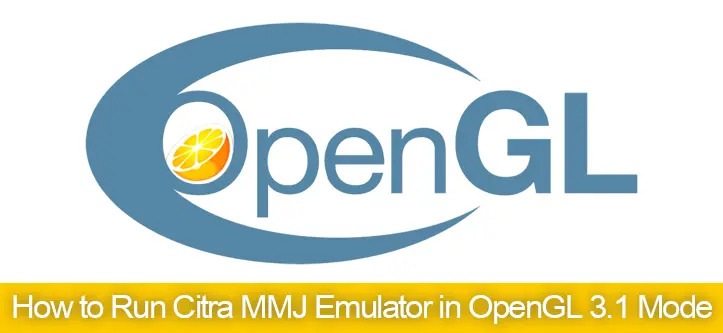The Citra MMJ emulator requires a compatible graphics backend to render 3DS games effectively. OpenGL is one of the supported backends, but for Citra MMJ to work in OpenGL 3.1, your system must meet specific hardware and software requirements.
What is OpenGL 3.1
OpenGL 3.1 is a widely used graphics API (Application Programming Interface) that provides tools for rendering high-quality 2D and 3D graphics. Released as an update to the OpenGL standard, version 3.1 introduced several performance and feature enhancements, including improved support for programmable shaders and buffer objects.
These advancements allow developers to create more detailed and visually appealing graphics in games and applications. For emulators like Citra MMJ, OpenGL 3.1 serves as a crucial backend that ensures efficient rendering and smooth performance, provided the hardware and drivers are compatible with the API.
Here’s a step-by-step guide to ensure that you can run Citra MMJ with OpenGL 3.1 successfully.
1. Check Your Device Compatibility
PC Users:
- GPU Requirements: Ensure your graphics card supports OpenGL 3.1 or higher.
- Operating System: Windows, macOS, or Linux with updated drivers.
- Driver Update: Update your GPU drivers from:
- NVIDIA: Official NVIDIA Drivers
- AMD: Official AMD Drivers
- Intel: Official Intel Drivers
Android Users:
- GPU Requirements: The device must support OpenGL ES 3.1.
- Chipset: Common supported GPUs include Qualcomm Adreno (400 series or newer) and Mali (T720 or newer).
Use apps like OpenGL Extensions Viewer to confirm your device’s OpenGL version.
Configure Citra MMJ for OpenGL 3.1
Once you confirm your device supports OpenGL 3.1, follow these steps to enable it in Citra MMJ:
For PC:
- Launch the Citra MMJ emulator.
- Go to Emulation > Configure > Graphics.
- Under the Graphics Backend option, select OpenGL.
- Set the internal resolution and other settings as needed for performance.
For Android (Citra MMJ):
- Open Citra MMJ on your device.
- Go to Settings > Graphics Settings.
- Choose OpenGL as the backend.
Optimize OpenGL Performance
Adjust Citra MMJ Settings:
- Internal Resolution: Use 1x Native for low-end devices and increase for higher-end hardware.
- Hardware Shader: Enable it for faster rendering.
- Shader Cache: Activate Disk Shader Cache to reduce stuttering.
- Accurate Multiplication: Disable it unless you experience graphical glitches.
Ensure Proper Cooling (For Android):
Use your device in a cool environment or with a cooling pad to prevent thermal throttling.
In addition to these settings, users should experiment with turning off additional graphics enhancements like texture upscaling or post-processing filters if performance lags. Balancing quality and speed is key, especially on older hardware. For demanding games, optimizing settings can dramatically improve performance.
Troubleshooting OpenGL 3.1 Issues
Common Problems and Fixes:
- Error: “OpenGL 3.3 or higher required”
- If your GPU only supports OpenGL 3.1, try Vulkan backend (if available).
- Ensure drivers are updated to the latest version.
- Poor Performance or Crashes
- Reduce internal resolution and disable extra features like texture filtering.
- Ensure your device meets the minimum system requirements.
- Black Screen Issue
- Disable Hardware Shaders in the graphics settings.
Some users may encounter issues where the emulator crashes upon startup or when launching certain games. This is often due to driver incompatibilities or incorrect emulator configurations. Updating drivers or switching to an alternative backend like Vulkan can address these problems effectively.
Alternatives to OpenGL 3.1
If OpenGL 3.1 doesn’t provide optimal performance or isn’t supported, consider switching to a different graphics backend:
Vulkan Backend:
- Supported on most modern GPUs.
- Provides better performance on Android and some PCs compared to OpenGL.
While OpenGL is a powerful option, Vulkan often delivers better results for users with compatible hardware. Exploring both options and benchmarking their performance on your system is an excellent way to determine the best fit for your needs.
Conclusion
Running Citra MMJ in OpenGL 3.1 requires compatible hardware, updated drivers, and proper configuration within the emulator settings. By optimizing the emulator settings and ensuring your device supports OpenGL 3.1, you can enjoy smooth gameplay with minimal graphical issues.
If OpenGL 3.1 fails to deliver the desired performance, consider using Vulkan or upgrading your hardware. Whether you’re revisiting classic 3DS games or trying out new ones, proper configuration ensures an enjoyable and frustration-free experience.
